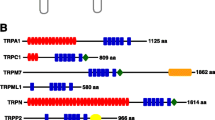Abstract.
Ion channels and receptors play critical roles in shaping neuronal activity, and thus are appropriate targets for evolutionary change to generate new behaviors. In this review, the evolution and differentiation of the many voltage-gated ion channels and transmitter-activated receptors is summarized; these channels and receptors evolved very early, and with some exceptions all species with nervous systems use similar sets of channels and receptors. Several examples are given of mechanisms for species-specific behavioral evolution that arise from mutations involving the structure, alternative splicing, level of expression, targeting and modulation of these important neural proteins.
Similar content being viewed by others
Author information
Authors and Affiliations
Additional information
Electronic Publication
Rights and permissions
About this article
Cite this article
Harris-Warrick, R. Ion channels and receptors: molecular targets for behavioral evolution. J Comp Physiol A 186, 605–616 (2000). https://doi.org/10.1007/s003590000133
Accepted:
Published:
Issue Date:
DOI: https://doi.org/10.1007/s003590000133




